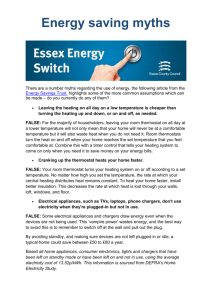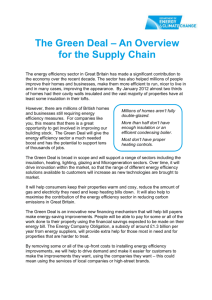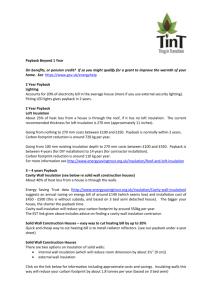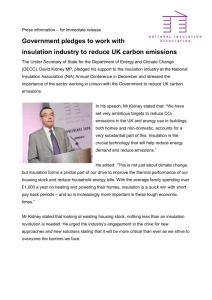Energy Savings Advice
advertisement
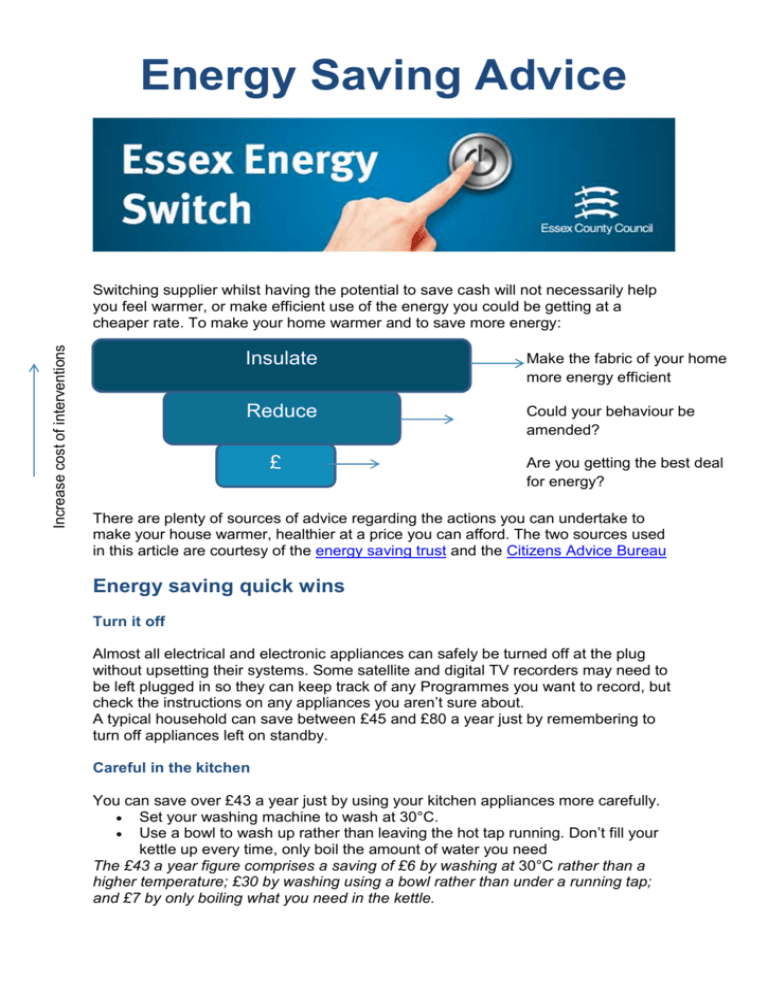
Energy Saving Advice Increase cost of interventions Switching supplier whilst having the potential to save cash will not necessarily help you feel warmer, or make efficient use of the energy you could be getting at a cheaper rate. To make your home warmer and to save more energy: Insulate Make the fabric of your home more energy efficient Reduce Could your behaviour be amended? £ Are you getting the best deal for energy? There are plenty of sources of advice regarding the actions you can undertake to make your house warmer, healthier at a price you can afford. The two sources used in this article are courtesy of the energy saving trust and the Citizens Advice Bureau Energy saving quick wins Turn it off Almost all electrical and electronic appliances can safely be turned off at the plug without upsetting their systems. Some satellite and digital TV recorders may need to be left plugged in so they can keep track of any Programmes you want to record, but check the instructions on any appliances you aren’t sure about. A typical household can save between £45 and £80 a year just by remembering to turn off appliances left on standby. Careful in the kitchen You can save over £43 a year just by using your kitchen appliances more carefully. Set your washing machine to wash at 30°C. Use a bowl to wash up rather than leaving the hot tap running. Don’t fill your kettle up every time, only boil the amount of water you need The £43 a year figure comprises a saving of £6 by washing at 30°C rather than a higher temperature; £30 by washing using a bowl rather than under a running tap; and £7 by only boiling what you need in the kettle. Get a head If you’ve got a shower that takes hot water straight from your boiler or hot water tank (rather than an electric shower), then you may be able to fit a water efficient shower head. This can reduce your hot water usage whilst retaining the sensation of a powerful shower. Some water companies are giving shower heads away for free. Contact your water company to see if you are eligible. By installing a water efficient shower head, a family of four could save around £65 a year on gas for water heating, as well as a further £95 on water bills if they have a water meter. The calculation is based on the assumption that the family takes just under 20 showers a week and replaces a 13 litre/minute power-shower head with a 7.7 litre / min water efficient shower head, and the family are charged £2.89 per cubic meter of water used (includes sewage charge). Draught excluders Unless your home is very new, you’re likely to be losing some heat through draughts around doors and windows, gaps around the floor, or through the chimney. Why not buy some draught-proofing products for doors and windows, seal your skirting boards with silicone sealant, and fit a chimney draught excluder or sealed fire guards. DIY draught-proofing of windows, doors and blocking cracks in floors and skirting boards can cost up to £200, but can save between £20 to £30 a year. New heating controls Whatever the age of your boiler, the right controls will let you: set your heating and hot water to come on and off when you need them heat just the areas of your home you want decide how warm you want each area to be. By installing a room thermostat, programmer and thermostatic radiator valves, you could save up to £70 to £150 a year. This allows you to make savings by using your controls more effectively. For example, turning down your room thermostat by just one degree, if it’s too warm inside, can save around £75. Loft insulation We recommend having at least 270mm (ten inches) of loft insulation, so it might be worth checking whether you could make your home warmer by topping up levels of loft insulation. You could save up to £150 a year if your loft is uninsulated by installing 270mm of insulation. Topping up existing insulation from 100mm to 270mm can save around £15 a year. Lighten your load You can now get LED spotlights that are bright enough to replace halogens, as well as regular energy saving bulbs (‘compact fluorescent lamps’ or CFLs). They come in a variety of shapes, sizes and fittings. If the average household replaced all of their remaining old-fashioned bulbs with CFLs, and all of their halogens with LEDs, it would cost about £110 and save about £45 a year. Cavity wall insulation For homes built after 1920, the chances are that the external walls are made of two layers of brick with a gap or cavity between them. Cavity wall insulation fills that gap, keeping the warmth in to save energy. The average installation cost for cavity wall insulation is between £450 and £500 and can save up to £145 a year. The measure could pay for itself in less than four years. Greater savings and income for renewable technology While the Feed-in-Tariff for solar PV panels is going down, the average cost for electricity is going up. In addition, the cost of panels is going down which means that now can be a great time to invest in solar PV. A typical 4kWP panel could generate and save you £750 per year. Despite costs falling over the last year, they do vary between installers and system sizes (costs can be between £6,000 and £7,400), so we recommend getting quotes from at least three MCS accredited installers. It’s also worth exploring renewable heating technologies, such as heat pumps, following the announcement of financial incentives through the Renewable Heat Incentive (RHI). Not only will households benefit from energy savings but they will also receive additional income for the energy produced. Whole house energy makeover There are plenty of other things that can be done to improve the energy performance of your home, such as floor and solid wall insulation, replacement doors and windows, or a new heating system. There may be schemes to help finance a comprehensive package of improvements. We recommend calling the Energy Saving Advice Service on 0300 123 1234 for guidance on the most appropriate package of improvements for you, and for information on available support.



